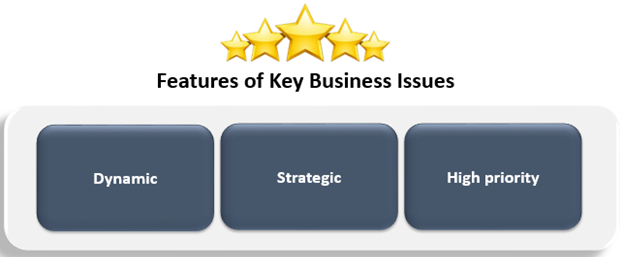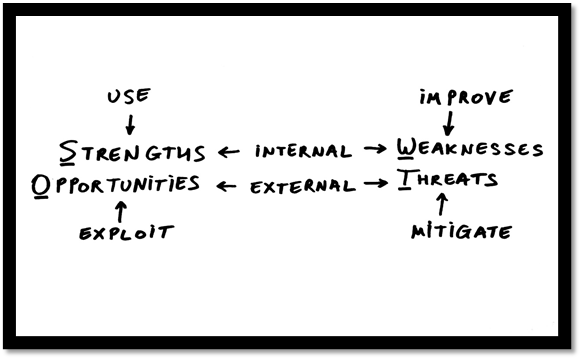Key Business Issue
-by Sukriti Nair (dt-18-06-2021)
A key business issue is a problem or opportunity that is critical for the success of an organization. The issue is generally related to the core operations of the business. It often affects a large group of people directly or indirectly related to the business. Affected may be customers, key stakeholders or employees. It can also be an illegal activity causing a regulatory risk. Key Business issues hold strategic importance. They need to be addressed in the organizational strategy, and operations need to be planned accordingly.
Summary
- Key Business Issues are critical opportunites or problems of a business that affect a large groupp of stakeholders.
- It is an issue that primarily impacts operations of an organisation either in present or in future.
- Organisations need to proactively look for these and address them for own benefit.
Frequently Asked Questions (FAQ)-
What makes a key business issue different?
All organizations face issues each day. Managers often get a lot of incidental information related to operational issues. Some bother it while others don’t. A Key Business issue is one that primarily impacts operations at any point in time.

Source: Copyright © 2021 Kalkine Media
Once information about a business issue is received, each team member must take out some time to assess its impacts. Recognizing strategic Issues deals with reviewing and noting the importance a piece of information holds. To differentiate a Key business issue from others, one needs to -
- Identify the most critical operations of a business.
- There is a need to frame questions that define its criticality.
- One must capture the vital Strategic Issues in an easy to view format.
- Management should then share this with the entire team.
- Key business issues are typically unique and dynamic. There are, however, some general ones that tend to remain due to the nature of business operations.
- Any issues related to a company’s strategic focus or its competencies by nature becomes critical.
- Issues caused by Culture modification in an organization also becomes a critical business issue that needs to be addressed immediately.
- Any kind of resource limitations that can cause production to stop is a high priority issue.
- Issues popping up from strategic alliances or takeovers also come in the Key Business Issue category
What are the common causes triggering key business issues?
The most common causes triggering Key Business Issues are-

Image Source: © Elen33 | Megapixl.com
- An uncertain future: Since it is impossible to predict market conditions accurately, there lies a certain level of uncertainty in a business’s future. No business can accurately predict the demand for its products or services. Therefore, external factors can trigger future loss.
- Faulty financing: Highly innovative and progressive organizations often need a lot of funds. If these funds are not appropriately estimated, it may lead to budgeted variances. It is not an ideal situation, and continuing variances can lead to losses in future. Cash or liquid assets need to be available as per business needs. If there is a cash crush for key business requirements, it is a critical issue.
- Unethical conduct: Serious misconduct and unethical practices can often bring severe troubles for a business. It is therefore essential to maintain an ethical work culture. The employee should focus on ethically achieving good results on Key performance indicators. No employee should choose misconduct to get results, as it can later lead to regulatory issues or hefty fines.
- Ineffective communication: Effective communication of rules, regulations and strategies is necessary for any organization. If employees do not know the correct practices or acceptable norms, they will not align with organizational goals. Thus an ineffective communication flow can lead to critical issues even from the smallest of errors.
- Competitors: The competition in the external environment can adversely influence critical business operations.
Example
X Bank Ltd. changes its compliance procedures to address critical business issues. It makes significant process changes to curb risks of potential money-laundering in international bank transfers.
How can SWOT analysis be used to identify key business issues?
Organizations should proactively look for critical business issues during strategy formation. Most companies, therefore, leverage SWOT analysis (Strength, Weakness, Opportunity, Threat) to start with the targeting of Key business issues.

Image Source: © Icefields | Megapixl.com
- As a part of the strategic initiatives SWOT, helps companies identify and address an area of weakness by utilizing its’ strengths and/or opportunities.
- Strengths give it an advantage over its competitors.
- Opportunities, on the other hand, help leverage core competencies for businesses advantage.
- Any Threat to the business as a whole becomes a Key business issue on its own
How can business reduce Key Business Issues?
Key business issues need to resolve on a priority basis. Once identified, managers should work to get some degree of resolution for each issue. A clear decision-making path must be identified that defines implementation.
Some practical steps to resolve Key Business Issues are:
- Start the discussion with basics. Define the scope of the issue before getting into its’ solution.
- Drive decision making related to the issue or additional steps needed later. A sense of future direction needs to be captured.
- Alternative solutions must be developed and recorded based on consensus. Exploring and evaluating downside risks and the probabilities of success for the alternatives is the best way to select an apt issue resolution strategy.
- Reviewing Mission Statement and Goals is also essential to identify areas in need of significant effort.
- All solutions suggested must reflect time efficiency by identifying key factors.
- All conflicting and implicit assumptions must be listed and appropriately communicated to resolve key cause-and-effect relationships.
- Often stepping back and challenging quality of solutions derived pre-identifies loopholes.
 Please wait processing your request...
Please wait processing your request...